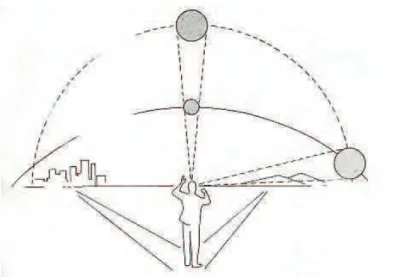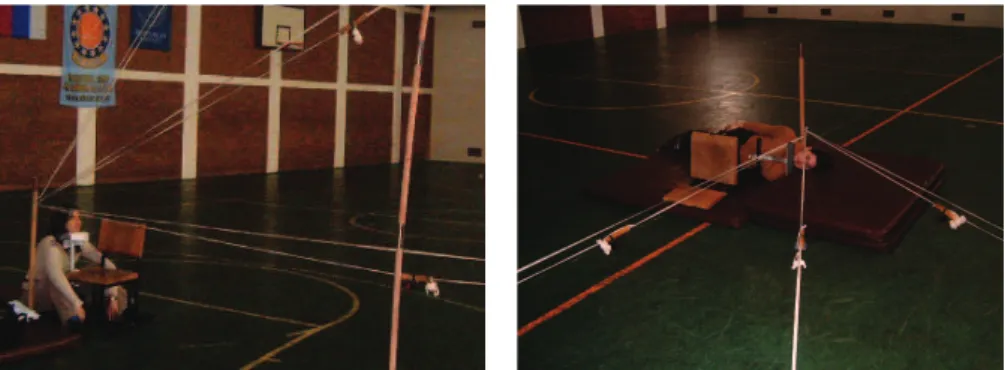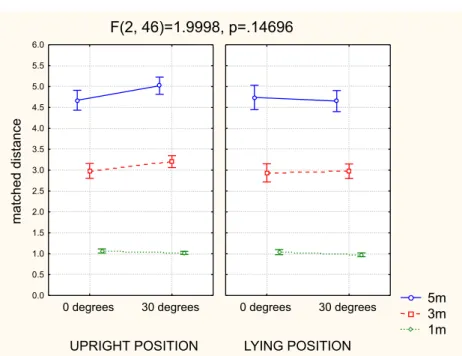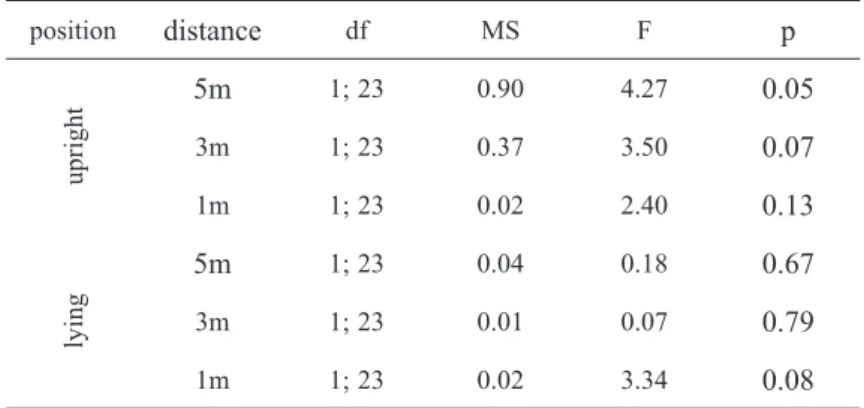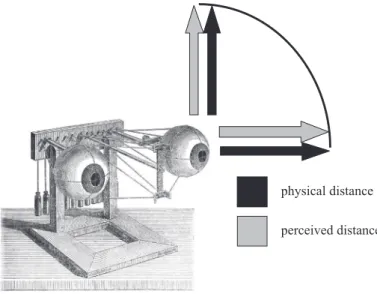© 2011 by the Serbian Psychological Association DOI: 10.2298/PSI1101023T
The anisotropy of perceived distance – the eyes story
Oliver Tošković
Laboratory for Experimental Psychology, Faculty of Philosophy, University of Belgrade, Serbia
The aim of this study is to determine whether the eye position shift changes perceived distance, that is, whether kinesthetic information from eye muscles affects distance perception. Two experiments were done, in a dark room (reduced-cue situation), with 27 participants, psychology undergraduates. Participants had a task to match distances of three stimuli, on three viewing directions, 0, 30 and 60 deg rees relative to the body. Head and body of participants were fixed, and they changed viewing directions only by moving their eyes. Stimuli were 7cm*5cm large, and rectangular in shape. In the first experiment participants were sitting upright, and in the second they were lying on a left side of their body. Results have shown that perceived distance did not change with viewing direction, in both experiments. That is, kinesthetic information from eye muscles did not change perceived distance. Therefore, we can conclude that the anisotropy of perceived distance is not a consequence of the change in kinesthetic information from eye muscles.
Key words: Distance perception, eye position shift, kinesthetic information, anisotropy
Depth perception is probably one of the oldest problems in psychology of perception. Namely, given that projections on the eye retina are two-dimensional, there is direct information on the retina for perceived object position only for two directions, left-right, and up-down with regard to the observer. Information for object distance with regard to the observer is lost during the projection on the retina. After one century of experiments we now know that perceived distance is reconstructed based on the so called depth cues, which emerge as a consequence of picture projection on the retina, and therefore visual system can use them to reconstruct the object distance. Depth cues can be classified in various ways, one of which is based on whether one (monocular) or both eyes (binocular) are necessary. So, monocular cues are accommodation, retinal image size, masking, perspective, shadows, density gradient, and optic flow, while binocular are convergence and disparity (for more see Palmer, 1999). However,
Corresponding author: otoskovi@f.bg.ac.rs
* This work was supported by the Ministry of Science and Technological Development of
the number, quality and type of depth cues are not the same in all parts of visual space. For instance, on distances near the observer, the number and quality of depth cues are much larger than in further parts of visual space. Also, beside visual, in nearer space there are tactile, olfactory, and some other information. Therefore, we can say that our visual space is not homogeneous, and we would expect perceived distance to vary in different parts of visual space. According to depth cues relevance, in physical space that we can perceive, Cutting and Vishton (1995) differentiate three zones: personal space (up to 2m, with convergence and accommodation as relevant depth cues), action space (up to 30m, with dynamic cues and perspective) and sight space (over 30m, with masking and perspective).
Perceived distance can also vary depending on viewing direction, and these variations of the same quality over different directions are called anisotropy. In one of the most plausible explanations of the Moon illusion, Rock and Kaufman’s hypothesis of, so called, flattened sky dome (Kaufman & Rock, 1962), authors claim that distances towards the zenith are perceived as shorter than physically equal distances towards the horizon (figure 1).
Figure 1. The flattened sky dome model
Nevertheless, there are various results which show the anisotropy of perceived distance, even if distribution of depth cues is the same towards both the horizon and the zenith. These results show that the cause of the anisotropy is probably not the difference between the viewing directions in the number and quality of depth cues. In most of these experiments subjects estimated or matched distances of horizontal and vertical stimuli in situations where the quality of depth cues was the same on both directions. Morinaga found that horizontal estimates are longer than the vertical ones for 4% to 14% (Higashiyama & Ueyama, 1988). Similar results were reported by Makishita and Ohno, Osaka, Higashiyama and Ueyama (Higashiyama & Ueyama, 1988). In addition, we performed an experiment in a forest, during the day light in which number and quality of depth cues were similar on horizontal and vertical direction. Participants matched distances of two stimuli, on two directions, ranging from 4m to 6m distance. Results showed that physically longer horizontal distances were matched with physically shorter ones, meaning that horizontal distances were perceived as being smaller than physically equal vertical ones (Tošković, 2009). We performed another experiment in a dark room, where the number and quality of depth cues were similar on horizontal and vertical direction as well. Participants also had a task to match distances of two stimuli, on two directions, ranging from 3m to 5m distance, and we gained the same result: vertical distances are perceived as being larger than physically equal horizontal ones (Tošković, 2004). In the conditions in which the number and quality of the depth cues are the same on horizontal and vertical direction, the difference in perceived distance still exists, which shows that the anisotropy of perceived distance is not caused by the difference in the quality of depth cues. Besides that, in all of the above mentioned experiments, physically longer horizontal distances were equalized with physically shorter vertical ones, which means that subjects perceived horizontal distances as shorter than the vertical ones. Namely, if someone, for instance, perceives 5m on horizontal direction as the same as 3m on the vertical one, those 5m are perceived as shorter, because they are equalized with 3m. These findings are contradictory to the flattened sky dome hypothesis which claims that vertical distances should be perceived as shorter. They show that the anisotropy of perceived distance exists, but in the opposite direction than the flattened sky dome hypothesis does. Also, it is not clear what causes this anisotropy.
convergence increase is followed by decrease in perceived size, but with no change in perceived distance (Epstein, 1969). Kilpatrick and Ittelson paralyzed accommodation in their subjects and found that it decreased perceived size and increased perceived distance, while retinal image size remained constant. Thus, in this experiment, for constant visual angle size, perceived size and distance varied in the opposite directions (Kilpatrick & Ittelson, 1953). Also, relation between perceived size and distance varies in different viewing conditions, and SDIH gives better predictions in water than in the air (Ross & Navaz, 2003).
Previously we showed that perceived distance is anisotropic, but in the opposite direction than the flattened sky dome model predicts. What about the perceived size? Maybe the perceived size changes as the flattened sky dome model predicts, independently of perceived distance.
Holway and Boring performed an experiment in which participants estimated the Moon size, while its position was changed by the mirror system. Results have shown that the change in perceived size appeared only with eyes position shift, and not with body position shift (Holway & Boring, 1940). Suzuki performed a similar experiment and showed that the difference in perceived size was larger if there was the eye position shift (1.1 times), while it was smaller if there was no eye position shift (1.06 times). He found the similar effects when he used afterimages as stimuli, instead of real objects. Based on these results Suzuki concludes that the eye position shift has an effect on perceived size (Suzuki, 2007). Thor wanted to examine the eye position effect on perceived size and distance in full range of elevations, from horizon to zenith. Given that it is not possible to change the position of the eye for 90 degrees (horizon-to-zenith), participants matched size and distance of the stimuli whose positions differed for 30 degrees of elevation. Then participants moved their body and matched the following two stimuli and so on, but Thor measured only the effects of the eye position shift. He showed that the eye position shift affected perceived size and distance in binocular vision, in such a way, that, when the gaze was shifted towards the zenith, stimuli were being perceived as smaller and further. Also, the effect of the eye position shift was larger on perceived distance than on perceived size (Thor et al., 1970). All these findings show the importance of the kinesthetic information from eye muscles for perceived size and the Moon illusion. They show that the anisotropy of perceived size, if it exists, might depend on the interaction between visual and kinesthetic information from eye muscles. What about perceived distance anisotropy? Does it depend on kinesthetic information from eye muscles?
us consider what changes when we move our gaze upwards, towards the zenith. We move our eyes, head, and body a little bit. So, the gaze direction change is followed by the change in kinesthetic information from eye muscles, neck muscles and vestibular information.
EXPERIMENTS
The aim of this research is to determine whether the eye position shift changes perceived distance, that is, whether kinesthetic information from eye muscles affects distance perception. Most of the previous findings regarding the change in the eye position examined perceived size, but not perceived distance. Also, it is hard to conclude whether there is an effect of the eye position shift on perceived size. Some results are gained in binocular, other in monocular conditions; various authors used different methodology, different measures, stimuli etc. Rock and Kaufman used the mirror system and lenses which by itself change perceived distance and therefore affect results; Holway and Boring did not use lenses, but they had other objects in visual space which subjects could compare with the Moon size; Thor compared various elevations but his results were confounded with the body position change. Ross and Plug tried to sum up all these findings and concluded that empirical data showed that there was an eye position effect on perceived size, but it was rather small and only around 7% of change in perceived size could be attributed to the eye position shift (Ross, 2002). Nonetheless, the question whether the eye position shift itself has an effect on perceived distance still remains.
Method
Participants: There were 27 participants in two experiments, Psychology undergraduates, both genders included. All participants had normal or corrected to normal vision.
Stimuli: Three luminous objects were used as stimuli, rectangular in shape, 7cm*5cm in size. Stimuli were emitting dim red light, which made them visible to subjects, but did not reveal any other objects in the room.
Procedure: Experiments were performed in a dark room, in reduced cue conditions, in which the number and quality of depth cues are equal on all viewing directions. Participants had a task to match distances of three stimuli positioned on three viewing directions. One direction, horizontal (0o), was perpendicular to the observer’s body main axis, the
second was 30o tilted towards the observer’s body, and the third was 60o tilted towards the
observer’s body. One of the stimuli was set on standard distance and participant’s task was to guide the experimenter (by giving him instructions “further” or “closer”) to move the other two stimuli until they appear on the same distance from the observer. All three stimuli were used as a standard, so, for instance, participants were first instructed to look at the 0o
stimulus and set up the other two, then they were instructed to look at the 60o stimulus and
a row. Thus, each subject made 36 matches (2 matches for one standard x 3 distances, x 3 standards (each direction was used as a standard) x 2 repetitions), which made the experiment last 30 minutes on average per subject.
Experiment 1: In the first experiment 16 participants were in an upright position, sitting on a floor, with their heads on a chinrest (figure 2). This means that they could change viewing directions only by moving their eyes, because their body and head were fixed on a chinrest. In this experiment horizontal direction was equal to direction towards the horizon.
Experiment 2: In the second experiment 15 participants were lying on a floor, on a left side of their body, also with their head on a chinrest (figure 2). As in the previous experiment, they could change viewing directions only by moving their eyes. In this experiment horizontal direction did not match direction towards the horizon; it was horizontal only with regard to the observer’s body. In this position, gravity direction is the same on all viewing directions, so it could not interact and therefore could not confound possible eye muscle effects on distance perception.
Figure 2. The experimental setting: a) the experiment 1, b) the experiment 2
Results
We used three-factorial ANOVA to analyze the data, in which two factors were repeated and the third was not. As factors we used body position (experimental condition, unrepeated), with two levels (upright and lying), viewing direction, with two levels, and standard distance, with three levels (1m, 3m and 5m). However, we could not compare all three viewing directions at once, since standard changed its position, once 0o stimulus was the standard, and then 30o and so on. That is, distance matches for each stimulus were gained based on two different standards, and averaging them would not be an adequate procedure. We performed three analysis, comparing each by each direction, 0o and 30o, 0o and 60o, 30o and 60o, and therefore viewing direction had two levels.
The effect of body position only shows that from lying condition (experiment 2) participants give smaller distance judgments, averaged across all distances and directions. Absence of viewing direction effect on matched distances, however, indicates that the eye position shift does not affect perceived distance. Also, none of the interactions were significant (table 1).
Table 1: Effects of body position, distance and viewing direction on perceived distance, for 0o and 30o viewing directions
df MS F p
POSITION 1; 23 0.42 5.20 0.03
DIRECTION 1; 23 0.17 0.88 0.36
DIRECTION*POSITION 1; 23 0.41 2.12 0.16
DISTANCE 2; 46 168.61 2452.32 0.00
DISTANCE*POSITION 2; 46 0.05 0.67 0.52
DIRECTION*DISTANCE 2; 46 0.14 2.08 0.14
DIRECTION*DISTANCE*POSITION 2; 46 0.13 2.00 0.15
Figure 3. Average matched distances for 0o and 30o viewing directions,
Further on, planned comparisons have shown that there are no significant differences between the two directions, on neither of the standard distances. The same result was gained for upright and lying body position (table 2). Thus, these results show that there are no differences in matched distances between 0o and 30o viewing directions.
Table 2: Planned comparisons for differences between 0o and 30o viewing directions
on three standard distances and two body positions
position distance df MS F p
upright
5m 1; 23 0.90 4.27 0.05
3m 1; 23 0.37 3.50 0.07
1m 1; 23 0.02 2.40 0.13
lying
5m 1; 23 0.04 0.18 0.67
3m 1; 23 0.01 0.07 0.79
1m 1; 23 0.02 3.34 0.08
Differences between 0o and 60o directions: the analysis showed significant main effect of standard distance only, while no effect of body position and viewing direction was shown (table 3). As we already mentioned, effect of distance was expected, while absence of viewing direction effect on matched distances indicates that the eye position shift does not affect perceived distance. Also, none of the interactions were significant (table 3).
Table 3: Effects of body position, distance and viewing direction on perceived distance, for 0o and 60o viewing directions
df MS F p
POSITION 1; 27 0.03 0.16 0.69
DIRECTION 1; 27 0.12 0.36 0.55
DIRECTION*POSITION 1; 27 0.86 2.54 0.12
DISTANCE 2; 54 208.21 1724.46 0.00
DISTANCE*POSITION 2; 54 0.10 0.85 0.43
DIRECTION*DISTANCE 2; 54 0.14 1.12 0.33
Figure 4. Average matched distances for 0o and 60o viewing directions,
on three standard distances and two body positions
Planned comparisons have shown that there are no significant differences between the two directions, on neither of the standard distances. The same result was gained for upright and lying body position (table 4). These results also show that there are no differences in matched distances between 0o and 60o viewing directions.
Table 4: Planned comparisons for differences between 0o and 60o viewing directions
on three standard distances and two body positions
position distance df MS F p
upright
5m 1; 27 0.31 1.20 0.28
3m 1; 27 1.17 4.01 0.06
1m 1; 27 0.01 0.20 0.66
lying
5m 1; 27 0.01 0.04 0.85
3m 1; 27 0.16 0.56 0.46
1m 1; 27 0.05 1.03 0.32
direction was shown (table 5). As said before, effect of distance was expected, while absence of viewing direction effect on matched distances indicates that the eye position shift does not affect perceived distance. Also, none of the interactions were significant (table 5).
Table 5: Effects of body position, distance and viewing direction on perceived distance, for 30o and 60o viewing directions
df MS F p
POSITION 1; 26 0.03 0.25 0.62
DIRECTION 1; 26 0.37 1.98 0.17
DIRECTION*POSITION 1; 26 0.17 0.88 0.36
DISTANCE 2; 52 195.66 1882.83 0.00
DISTANCE*POSITION 2; 52 0.09 0.87 0.43
DIRECTION*DISTANCE 2; 52 0.09 1.08 0.35
DIRECTION*DISTANCE*POSITION 2; 52 0.06 0.77 0.47
Figure 5. Average matched distances for 30o and 60o viewing directions,
on three standard distances and two body positions
6). These results also show that there are no differences in matched distances between 30o and 60o viewing directions.
Table 6: Planned comparisons for differences between 30o and 60o viewing directions
on three standard distances and two body positions
position distance df MS F p
upright
5m 1; 26 0.16 0.72 0.40
3m 1; 26 0.46 3.96 0.06
1m 1; 26 0.02 1.22 0.28
lying
5m 1; 26 0.05 0.23 0.64
3m 1; 26 0.08 0.69 0.41
1m 1; 26 0.04 2.89 0.10
DISCUSSION
The aim of this research was to investigate whether the eye position shift alone had an effect on perceived distance. The distance matching task was used, and subjects matched distances of stimuli in a reduced cue condition, on three viewing directions, 0o, 30o, and 60o. Reduced cue condition means that the number and quality of depth cues were decreased, since we used a dark room. In this condition, some depth cues are available, such as accommodation, retinal image size, convergence and binocular disparity, but for the aim of this study it was important that their presence was the same on three different viewing directions. Results gained in the first experiment, in an upright position, show that matched distances were the same on three directions, 0o, 30o, and 60o. That is, perceived distance did not change with viewing direction. Since observers moved only their eyes during the viewing direction change, we can conclude that the eye position shift does not have an impact on perceived distance. More precisely, these results show that kinesthetic information from eye muscles do not change perceived distance. However, some might argue that moving the eyes upwards coincides with gravity direction. Namely, if we look straightforward, our gaze direction is perpendicular to gravity, but if we look upwards, the angle between gaze direction and gravity decreases. So if we move our eyes upwards, eye muscle tension changes not only due to the eye position shift, but also due to gravity opposing.
gravity and viewing direction remains the same; they are always perpendicular to each other. Results gained in the second experiment also showed that matched distances were the same on all three directions.
On the other hand, we might ask if the 60o viewing direction was too extreme, and if it was painful for subjects to move the eyes in that direction, which might lead to some disturbance in gained results. Therefore, we asked subjects, and none of them reported any difficulty during the experiment regarding the change in viewing directions. Also, the experimenter did the experiment himself, and 60o direction was not difficult to reach. Finally, based on the results from both experiments we can conclude that the eye position shift does not change perceived distance, i.e. kinesthetic information from eye muscles do not affect perceived distance. Since perceived distance in these conditions remains the same on different viewing directions, we can say that perceived distance is isotropic in these conditions (figure 6).
Figure 6. Isotropy of perceived distance due to eye position shift
of perceived distance, neither that the anisotropy is such that perceived distances are shorter towards the zenith. It only shows that kinesthetic information from eye muscles do not cause the anisotropy of perceived distance. As we previously said, kinesthetic information from eye muscles is just one factor that changes when we move our gaze upwards. Besides that, kinesthetic information from neck muscles and vestibular information also change, and there are some results which show the importance of this kind of information for perceived distance (Suzuki, 2007; Higashiyama & Adachi, 2006; Lackner & Di Zio, 2005; Cohen & Stoper, 2001; Carter, 1977, Tošković, 2010).
On the other hand, there are findings which show an effect of the eye position shift on perceived size (Suzuki, 2007; Thor et al., 1970; Holway & Boring, 1940). These findings do suggest that kinesthetic information from eye muscles might have some effect on perceived size, but not on perceived distance. The authors mentioned above were mostly interested in the Moon illusion phenomena and they investigated perceived size only. Nevertheless, it might be expected that if a certain factor affects perceived size, it will affect perceived distance as well. However, these kinds of expectations are based on the Size-Distance Invariance Hypothesis, that is, they assume that perceived size and distance depend on each other. As we already mentioned, there are many results which show that distance and size can be perceived independently (Ross & Navaz, 2003; Loomis & Philbeck, 1999). Sometimes perceived size and distance do have some common factors they depend on, but these two perceptual variables are not directly linked to each other. But, as we mentioned, Thor showed that the eye position shift did have some impact on perceived distance, too (Thor, 1970). His results, on the other hand, are such that they do not allow us to conclude that the eye position shift causes change in perceived distance, because his participants moved their body as well. So, it is not clear whether changes in perceived distance in Thor’s experiment can be attributed to either kinesthetic information from eye muscles, vestibular information, or to their interaction.
To conclude, our study shows that kinesthetic information from eye muscles do not affect perceived distance. In other words, in reduced cue situation, when viewing direction is changed by the eye position shift, perceived distance remains isotropic. This means that kinesthetic information from eye muscles do not cause the anisotropy of perceived distance gained in some previous experiments (Higashiyama & Ueyama, 1988; Tošković, 2004, 2009).
and kinesthetic information from eye muscles. Then, we can assume that other factors, such as kinesthetic information from neck muscles or vestibular information, can cause perceived distance anisotropy. Nevertheless, we might ask why interactions between visual and kinesthetic or vestibular information would affect perceived distance. We can assume that the reason might be in effectiveness of action. So, if visual information would be insufficient, for example in a dark room, some other sensory modality information might be useful to us, in order to perform action more efficiently, and, for example, grab something. Kinesthetic and vestibular sensory modalities might be the additional information which we use, in order to correct or to complement visual input, and to gain more precise percepts, such as better estimate of object distance. Why kinesthetic and vestibular information? These information tell us something about ours and our body parts position, which is important during an action, and coordination between visual and kinesthetic or vestibular input might be crucial for action performing. Of course, it remains to verify this kind of hypothesis, and to prove that kinesthetic information from neck muscles, or vestibular information do affect perceived distance. In addition, these kinds of findings would help us to broaden our understanding of basic perceptual mechanisms of distance perception, and to include, beside visual depth cues, other sensory information which might be important.
REFERENCES
Carter, D. S. (1977). The moon illusion: a test of the vestibular hypothesis under monocular viewing conditions. Perceptual and Motor Skills,45, 1127–1130.
Cohen, M., & Stoper, A. (2001). Effects of gravitational and optical stimulation on the perception of target elevation. Perception and psychophysics, 63, 29–35.
Cutting, J. E., & Vishton, P. M. (1995). Perceiving layout and knowing distances: the integration, relative potency, and contextual use of different information about depth. In: W. Epstein, & S. Roger (Eds.), Perception of Space and Motion (pp. 69–117). New York: Academic Press.
Epstein, W. (1969). Size and distance judgments under reduced conditions of viewing.
Perception and Psychophysics, 6, 269–272.
Higashiyama, A., & Ueyama, E. (1988). The perception of vertical and horizontal distances in outdoor settings. Perception and Psychophysics, 44, 151–156.
Higashiyama, A., & Adachi, K. (2006). Perceied size and perceived distance of targets viewed from between the legs: Evidence for proprioceptive theory. Vision Research, 46, 3961–3976. Holway, A. H. & Boring, E. G. 1941. Determination of apparent visual size with distance
variant. American Journal of Psychology, 54, 21–37.
Holway, A. H., & Boring, E. H. 1940. The moon illusion and the angle of regard. American Journal of Psychology, 53, 109–116.
Kaufman, L., & Rock, I. (1962). The Moon Illusion. In R, Held, & W, Richards (Eds.),
Perception: Mechanisms and Models (pp. 260–268). San Francisco: W. H. Freeman and Company.
Lackner, J. R., & DiZio, P. (2005). Vestibular, proprioceptive, and haptic contributions to spatial orientation. Annual Review of Psychology, 56, 115–147.
Loomis, J. M., & Philbeck, J. W. (1999). Is the anisotropy of perceived 3-D shape invariant across scale? Perception & Psychophysics, 61(3), 397–402.
Palmer, S. (1999). Vision Science. London: A Bradford Book The MIT Press.
Ross, H. E., & Nawaz, S. (2003). Why do objects appear enlarged underwater? Arquivos Brasileiros de Pftalmologia, 66, 69–76.
Ross, H., & Plug, C. (2002). The mystery of the moon illusion. New York: Oxford University Press.
Suzuki, K. (2007). The moon illusion: Kaufman and Rock’s (1962) apparent-distance theory reconsidered. Japanese Psychological Research, 49(1), 57–67.
Thor, D. H., Winters, J. J., & Hoats, D. L. 1970. Eye elevation and visual space in monocular regard. Journal of Experimental Psychology, 86(2), 246–249.
Tošković, O. (2004). Oblik perceptivnog modela prostora. Psihološka istraživanja, XIV, 85–123.
Tošković, O. (2009). Važnost vizuelnih i nevizuelnih informacija za anizotropiju opažene daljine. Psihologija, 42(2), 255–268.
